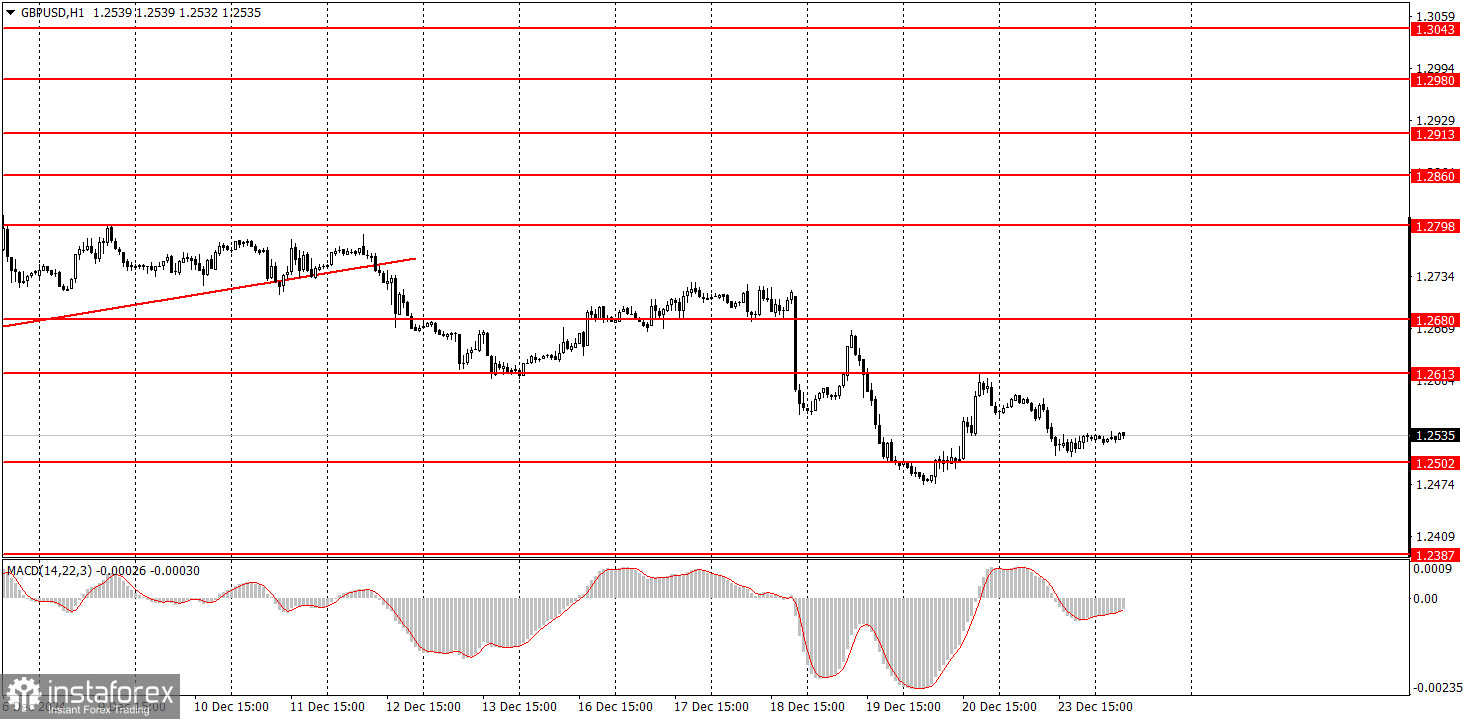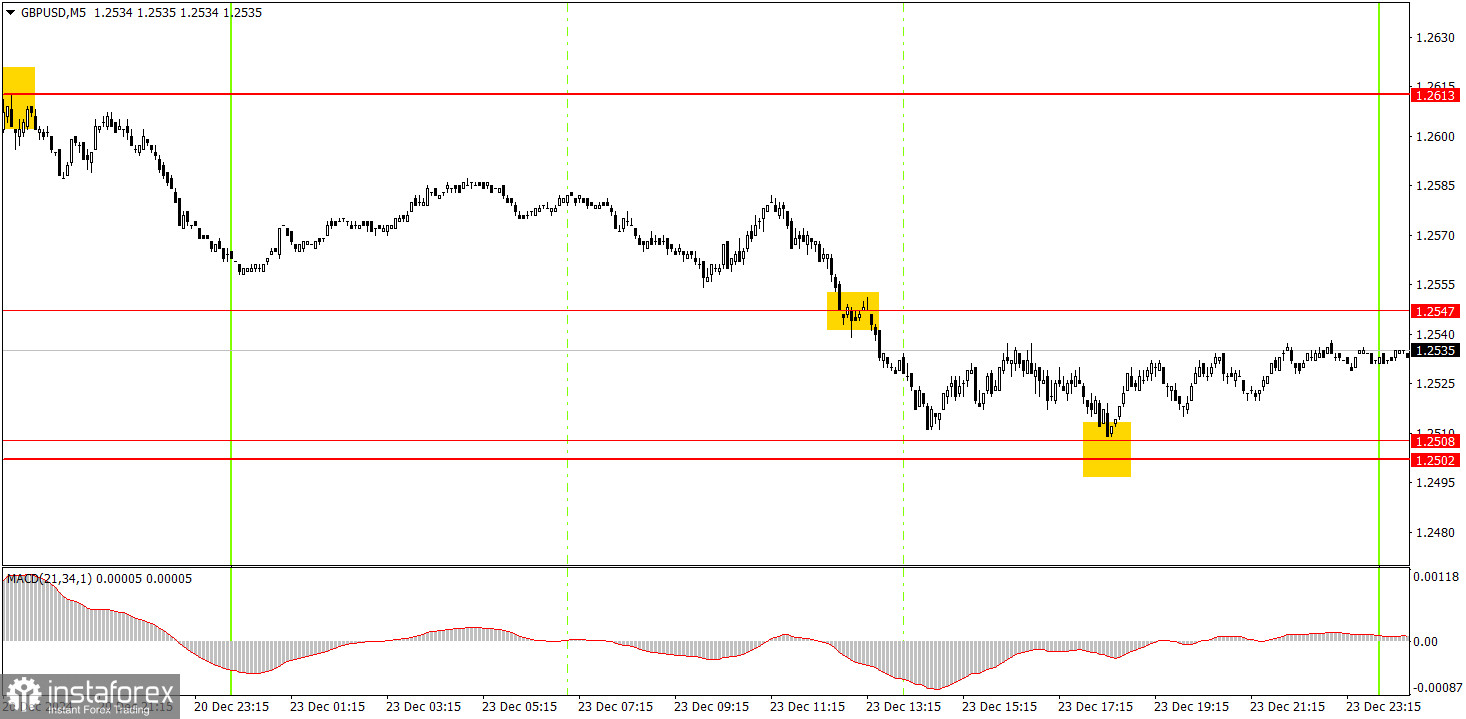Analysis of Monday's Trades
1H Chart of GBP/USD

On Monday, the GBP/USD pair traded lower, approaching the lows seen last week. The UK released one report on Monday that, unsurprisingly, did not support the British currency. The UK economy exhibited weaker-than-expected growth in the third quarter, and the second-quarter figures were also revised downward. This situation naturally justified the pound's decline. However, it appears that the British pound may continue its downward trend even without local macroeconomic factors, as it remains overbought and unjustifiably expensive. While we are not likely to see significant movements this week, there is nothing to stop remaining traders from continuing to push the pair down in alignment with the overall trend.
5M Chart of GBP/USD

On the 5-minute timeframe, two trading signals were generated on Monday. However, the key signal occurred on Friday. On that day, the price rebounded from the 1.2613 level, which triggered a significant decline. Opening trades just before the market closed on Friday involved considerable risk, but the signal was clear and played out as expected. On Monday, the price broke below the 1.2547 level and only paused near the 1.2502–1.2508 range. The bounce from this area acted as a buy signal.
Trading Strategy for Tuesday:
On the hourly timeframe, the GBP/USD pair has completed its upward correction. In the medium term, we fully anticipate a decline in the pound, as this seems to be the most logical direction. However, it is important to note that the pound sterling faces strong resistance against the U.S. dollar. Therefore, while a decline is expected, traders should rely on technical signals. The outcomes of the Bank of England and Federal Reserve meetings strongly support the continuation of a bearish trend.
On Tuesday, the GBP/USD pair may experience a slight increase, as it was unable to break through the resistance zone of 1.2502–1.2508. However, a further decline still appears to be the more likely outcome.
For trading on the 5-minute timeframe, consider the following key levels: 1.2387, 1.2445, 1.2502–1.2508, 1.2547, 1.2633, 1.2680–1.2685, 1.2723, 1.2791–1.2798, 1.2848–1.2860, 1.2913, and 1.2980–1.2993. On Tuesday, there will be only one significant macroeconomic report released—the U.S. durable goods orders. Additionally, please note that Wednesday is a holiday.
Core Trading System Rules:
- Signal Strength: The shorter the time it takes for a signal to form (a rebound or breakout), the stronger the signal.
- False Signals: If two or more trades near a level result in false signals, subsequent signals from that level should be ignored.
- Flat Markets: In flat conditions, pairs may generate many false signals or none at all. It's better to stop trading at the first signs of a flat market.
- Trading Hours: Open trades between the start of the European session and the middle of the US session, then manually close all trades.
- MACD Signals: On the hourly timeframe, trade MACD signals only during periods of good volatility and a clear trend confirmed by trendlines or trend channels.
- Close Levels: If two levels are too close (5–20 pips apart), treat them as a support or resistance zone.
- Stop Loss: Set a Stop Loss to breakeven after the price moves 20 pips in the desired direction.
Key Chart Elements:
Support and Resistance Levels: These are target levels for opening or closing positions and can also serve as points for placing Take Profit orders.
Red Lines: Channels or trendlines indicating the current trend and the preferred direction for trading.
MACD Indicator (14,22,3): A histogram and signal line used as a supplementary source of trading signals.
Important Events and Reports: Found in the economic calendar, these can heavily influence price movements. Exercise caution or exit the market during their release to avoid sharp reversals.
Forex trading beginners should remember that not every trade will be profitable. Developing a clear strategy and practicing proper money management are essential for long-term trading success.





















